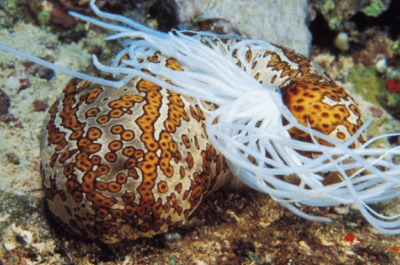
Sea cucumbers: those cute log-like animals munching their way along the sea floor. These cylindric invertebrates are part of the phylum Echinodermata which translates to “spiny skin”.
Echinodermata is a completely marine based phylum that includes sea stars, sea urchins and of course, the lovable sea cucumbers. Most days you can find innocent sea cucumbers minding their own business and sucking up sand and mud like a vacuum. The sea cucumber sifts through and feeds on the organic pieces hidden in the sediment. If you have visited CIMI, you may have had the pleasure of holding a sea cucumber that can be found in our cove, Parasichopus californicus, or the warty sea cucumber. A muddy orange-brown color, these guys are named after the wart like bumps that cover their body.

Sea cucumbers, like the warty sea cucumber, are eaten by a number of different organisms. Predators include types of crabs, fish, sea stars and sometimes sea turtles. How do these spineless logs defend themselves against predators? They can not move very fast, so a quick escape is rarely an option. Sea Cucumbers have evolved a very interesting and gross way to escape possible death by crab or fish. Evisceration!

Evisceration basically means exploding guts. The root word in eviseration, “visera” means “intestines”. When a sea cucumber feels threatened it can spew its intestines and other internal organs at a predator. The predator is distracted by the free snack, allowing the sea cucumber to inch away. Evisceration begins when the attatchment tissues that hold the internal organs, like the intestines or respratory gills, soften. If you’ve ever touched a sea cucumber you’ll have noticed that its body toughens and becomes rigid. Left alone it will losen up and soften again. Like many echinoderms, sea cucumbers can toughen or soften their body texture at will. Once the attachment tissue softens and becomes almost liquidfied, spots on the body where the organs will soon spew out begin to soften too. Depending on the species, the evisteration point can be on the anterior (front) or the posterior (back) end of the sea cucumber. Softening takes between one to three minutes. The sea cucumber muscles contract and expell the internal organs! It can take between 20 minutes to 12 hours to complete the process of eviseration. Now that the sea cuumber has rid itself of most its organs and escaped being eaten, it must begin to regenerate. Regenerating its interal organs can take as long as 145 days and as short as 7 days. It depends on the species, age of the organism and the time of year.
Although evisceration is often associated with defense and escape, this is not always the case. It depends on the species of sea cucumber. Some sepecies, like the warty sea cucumber, eviserate seasonally to get rid of excess waste. In addition, during food shortages, sea cucumbers have been know to eviserate. It is actually a larger metabolic load or energy drain on the sea cucumber to hold onto excess waste than to eviserate and regenerate.
Sea cucumbers are pretty amazing! They can live without their internal organs for weeks and spew their guts at predators. They might be gutless at times, and spineless, but they got a lot of spunk for an animal named after a cucumber.
Source:
http://echinoblog.blogspot.com/2012/01/sea-cucumber-evisceration-defense.html
Photo:
Leopard sea Cucumber – http://phenomena.nationalgeographic.com/2016/05/10/how-this-fish-survives-in-a-sea-cucumbers-bum/


